 klaus-michael schneider
klaus-michael schneider
Keywords: education |
Links: FOTW homepage | search | disclaimer and copyright | write us | mirrors

Last modified: 2021-02-05 by  klaus-michael schneider
klaus-michael schneider
Keywords: education |
Links: FOTW homepage |
search |
disclaimer and copyright |
write us |
mirrors
![[Flag of Colombia]](../images/c/co.gif) (2:3)
(2:3)  image by Željko Heimer, 20 May 2001
image by Željko Heimer, 20 May 2001
See also:
Other Institutions:
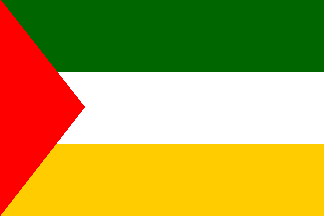 image by Ivan Sache, 24 September 2014
image by Ivan Sache, 24 September 2014
Liceo Samper Uribe was established in 1967 in Sibaté (Cundinamarca
Department) by Gustavo Quijano Velandia, as Gimnasio Frances Honorato de Balzac.
The institute was renamed Liceo Samper Uribe the next year, as a tribute to the
contribution of the Samper and Uribe families to the socio-economic development
and establishment of the municipality of Sibaté.
The flag of the institute is horizontally divided emerald green-white-yellow,
with a red triangle placed along the hoist. The triangle is a symbol of harmony
and perfection. Green is a symbol of hope. White is a symbol of purity. Yellow is
a symbol of splendour and joy. Red is a symbol of life, youth, and vigour.
Source:
http://www.liceosamperuribe.com/joomla/index.php/colegio/simbolos -
Institute's website
Photos:
http://www.liceosamperuribe.com/joomla/index.php/galeria/image?view=image&format=raw&type=orig&id=109
http://www.liceosamperuribe.com/joomla/index.php/galeria/image?view=image&format=raw&type=orig&id=110
http://www.liceosamperuribe.com/joomla/index.php/galeria/image?view=image&format=raw&type=orig&id=64
Ivan Sache, 24 September 2014
 image by Ivan Sache, 24 September 2018
image by Ivan Sache, 24 September 2018
Colegio San Agustín was established in 1956 in San Agustín borough,
Facatativa (Cundinamarca Department), by Carlos Julio Cárdenas Villamizar,
Ismael Carvajal and Alejandro de la Torre. In 1980, the school was taken over by
Martínez Ltda., a company founded by Raúl Heráclito Martínez Sánchez, Myriam
Gladis Martínez, Adiela de González, Carmen Fabiola Martínez de Yomayusa, Amanda
Martínez, Carlota Martínez de López and Gloria Elsy Martínez.
http://www.colegiosanagustinfacatativa.edu.co/
School website
The
flag of Colegio San Agustín is divided blue-green by an ascending diagonal white
stripe.
Green, the image of the natural environment, represents aspiration to
growth, youth, friendship, community service and ecological awareness.
White,
a symbol of purity, represents transparency, mind clarity, perceptiveness, truth
and rectitude.
Blue represents intelligence, joy, adolescence, felicity,
loyalty, honor and spiritual maturity.
http://www.colegiosanagustinfacatativa.edu.co/simbolos.html#bandera
School website
Ivan Sache, 24 September 2018
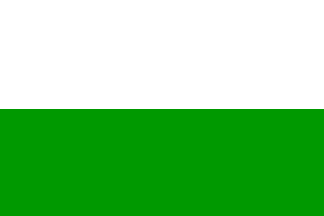 image by Ivan Sache, 25 September 2014
image by Ivan Sache, 25 September 2014
Escuela San Agustín was established on 8 October 1888 in Popayán (Cauca
Department) by Sister Antoinette Lafay, member of the Sisters of Charity of
Saint Vincent de Paul, a congregation founded in 1633 by St. Vincent de Paul
(1581-1660; canonized on 16 June 1737 by Pope Clement XII) and St. Louise de
Marillac (1561-1660; canonized on 11 March 1934 by Pope Pius XI). Concentración
Escolar San Agustín was established in 1955. Lacking staff, the Sisters of
Charity had to abandon the management of the institute in 1998. His Grace Iván
Antonio Marín, Archbishop of Popayán, commissioned the Sisters of the Charity of
St. Ann, a congregation founded by María Rafols (1781-1853) and Juan Bonal
(1769-1829), to take over the institute.
The flag of the institute is horizontally divided white-green. White is a symbol
of faith and purity. Green is a symbol of honour, friendship, and courtesy.
Source:
http://sanagustinpopayan.edu.co/index.php/component/content/category/9-institucion
- Institute's website
Ivan Sache, 25 September 2014
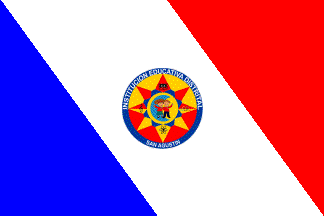 image by Ivan Sache, 30 October 2011
image by Ivan Sache, 30 October 2011
"Institucion Educativa Distrital San Agustin" was founded in 1970 in Bogotá.
The flag of the institute is diagonally divided blue-white-red with the
institution's emblem in the middle.
Blue symbolizes intelligence, truth and knowledge. White symbolizes aspiration
to peace and social development. Red symbolizes passion, love, action and
triumph.
The emblem was selected in a contest opened to students and professors in art.
The emblem is horizontally divided yellow-red with an eight-pointed star all
over; the rays of the star are counter-colored. The ray pointing to the north is
charged with an open black book charged with the white letters "SA" (for "San
Agustin"), while the ray pointing to the south is charged with the black symbol
of atomic physics (a black nucleus surrounded by three black ellipses
representing electron's orbits). The ray pointing to the west is charged with a
black G-clef, while the ray pointing to the east is charged with the Olympic
rings.
In the middle of the sun is a yellow disk, separated from the rays by blue
pentagons. The disk is charged with a light blue crescent and a girl and a boy
wearing the uniform of the institute. The emblem is surrounded by a blue ring
charged with the name of the institute, written in white capital letters.
Source:
http://fr.calameo.com/read/0004137826eea57ba4c75
Ivan Sache, 30 October 2011
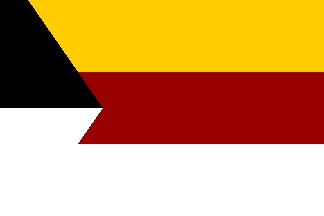 image by Ivan Sache, 26 June 2014
image by Ivan Sache, 26 June 2014
Colegio San Alberto Magno (COLSAM) was established on 5 December 1974 by the
Order of Preachers (Dominicans) in the San Luis borough of Barranquilla
(Atlántico Department).
The college is named for St. Albertus Magnus (1206-1280; canonized on 16
December 1931 by Pope Pius XI), a German Dominican friar considered as the
greatest German philosopher and theologian of the time.
The flag of the institute, as seen on several photos available on the
institute's website, is horizontally divided yellow-red-white with a triangle
horizontally divided black-white placed along the hoist.
http://www.colsam.edu.co/web/images/phocagallery/2012/210entregasimbolos/thumbs/phoca_thumb_l_img_0438.jpg
http://www.colsam.edu.co/web/images/phocagallery/2013/30anos200/thumbs/phoca_thumb_l_dsc_0036.jpg
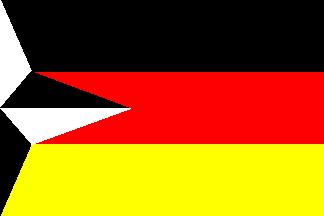 image by Ivan Sache, 26 June 2014
image by Ivan Sache, 26 June 2014
Another flag is shown graphically and described in great detail on the
institute's website. This flag is horizontally divided black-red-yellow with a
half-star faceted white and black placed along the hoist. The flag is based on
the national flag of Germany, the country of St. Albert the Great. The black and
white star recalls the coat of arms of the Order of Preachers, founder and
manager of the institute.
Black and white are the colours of the cloak of the Friars Preachers; black,
absorbing light and colours, is a symbol of contemplation, while white,
projecting and reflecting them, is a symbol of predication. White and black are
the expression of the fraternal kiss of the Colombian Caribbean race, which
struggles for peace and the eradication of all kind of racial, political and
religious discrimination. Red is a traditional symbol of love and sacrifice,
which initiate evangelical compassion in the institute's college. Yellow is a
symbol of the Gospel's light that enlightens the man's life. Yellow and red
recall the sandy ravines of the town, which was awarded the title of Colombia's
Golden Gate.
Source:
http://www.colsam.edu.co/web/index.php?option=com_content&view=article&id=51&Itemid=92
- Institute's website
Ivan Sache, 26 June 2014
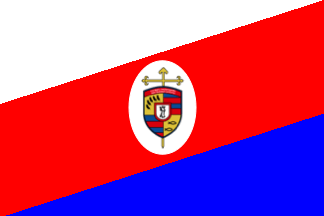 image by Ivan Sache, 3 January 2021
image by Ivan Sache, 3 January 2021
Colegio Parroquial San Andrés Apóstol bwas established in Fontibón Centro,
Bogotá, by the Fundación Educativa Santiago Apostol.
The flag of Colegio
Parroquial San Andrés Apóstol is divided white-red-blue from the lower hoist to
the upper fly, charged in the center with the school's coat of arms inscribed in
a white oval.
White represents light, knowledge and wisdom.
Red represents
sacrifice, force and commitment to great causes.
Blue represents liberty and
presence of love via Jesus.
In the center of the coat of arms is placed a
white escutcheon portraying Apostle St. Andrew bearing his cross.
In the
first and third quarter, the five breads and the two fish, respectively
symbolizes St. Andrew as the master of solidarity*.
In the second and third
quarters, the red and blue stripes recall the school's colors. Red symbolizes
St. Andrew's martyr. Blue symbolizes glory achieved for having offered his life
for Jesus' love.
Gold symbolizes sanctity.
The Cross of Saint James
symbolizes union with the Fontibón diocese.
https://fesa.edu.co/colegio-parroquial-san-andres-apostol
School website
*John 6:8-9 : "Another of his disciples, Andrew, Simon Peter's brother,
spoke up, "Here is a boy with five small barley loaves and two small fish, but
how far will they go among so many?"
Ivan Sache, 3 January 2021
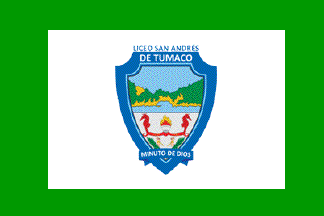 image by Ivan Sache, 12 March 2017
image by Ivan Sache, 12 March 2017
Liceo San Andrés de Tumaco was established in 2014 in Tumaco, Nariño
Department, by Corporación Educativa Minuto de Dios, a corporation founded in
1958 by Father Rafael García Herreros Unda (1909-1992), which manages 24
educational institutes all over Colombia.
http://www.colegiosminutodedios.co/tumaco/index.php/ - Institute's website
The flag of the institute is white with a green border and the institute's
emblem in the center. The emblem of the institute is made of the municipal
emblem of Tumaco, with added writing, "LICEO SAN ANDRÉS / DE TUMACO" (top) and
"MINUTO DE DIOS" (bottom).
http://www.colegiosminutodedios.co/tumaco/index.php/quienes-somos/nosotros/simbolos
- Institute's website
Ivan Sache, 12 March 2017
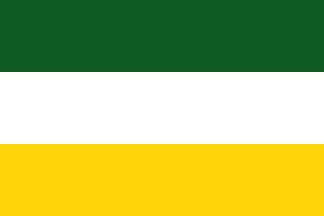 image by Ivan Sache, 14 June 2018
image by Ivan Sache, 14 June 2018
Institución Educativa San Antonio de Padro (SADEP) was established by
Departmental Resolution No. 16,348,adopted on 27 November 2002, as the merger of
Escuela Carlos Betancur Betancur, Escuela Manuel María Mallarino, Liceo San
Antonio de Prado, and Sede Rural Potrerito.
Source: SADEP website
The flag of SADEP is horizontally divided green-white-yellow. Green represents
aspiration to a better future in a democratic, fair and peaceful country;
respect for nature and environment. White means peace. Yellow represents the sun
as a source of life and abundance.
Source:
SADEP website
Ivan Sache, 14 June 2018
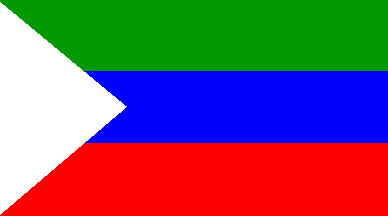 image by Ivan Sache, 28 March 2009
image by Ivan Sache, 28 March 2009
"Institución Educativa 'San Antonio de Padua' "
(IESAP) was founded in 1906 by Próspero Restrepo at Támesis,
Department of Antioquia. Originally named "Colegio de San
Antonio", the institute was successively renamed "Liceo
Alejandro Próspero Reverend" (1952), "Liceo Regional
Alejandro Próspero Reverend" (1961) and "Liceo
Regional Rafael J. Méjía" (Decree No. 1415, 28 September
1966). IESAP was officially founded on 7 February 2003 (Decree
No. 865) as the merger of "Liceo Regional Rafael J.
Méjía", "Escuela Eladia Mejía González" and
"Preescolar Mis Amiguitos".
The flag of IESAP, as shown graphically on the website
of the institute, is horizontally divided green-blue-red with
awhite triangle placed along the hoist.
It was presented, together with the emblem of the institute,
during the celebration of the 100th anniversary of the institute,
held on 14 August 2006.
Ivan Sache, 28 March 2009
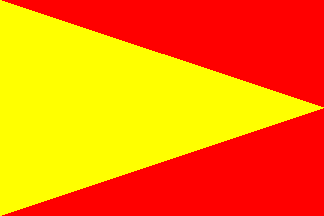 image by Ivan Sache, 26 June 2014
image by Ivan Sache, 26 June 2014
Colegio San Antonio María Claret was established on 12 October 1959 in Cali
(Valle del Cauca Department) by the Congregation of Missionaries Sons of the
Immaculate Heart of Mary (Claretians).
The Claretians, a congregation founded on 16 July 1849 by the Catalan priest
Anthony Mary Claret (1807-1870; canonized on 7 May 1950 by Pope Pius XII),
settled in Cali in 1951.
The flag of the institute is garnet red with a yellow triangle placed along the
hoist and reaching the mid-fly. Garnet red is a symbol of strength, commitment,
passion, desire and love.
Yellow is a symbol of the sunlight, joy, felicity, cleverness and energy.
Source:
http://www.colegioclaret.edu.co/simbolos.html
Ivan Sache, 26 June 2014